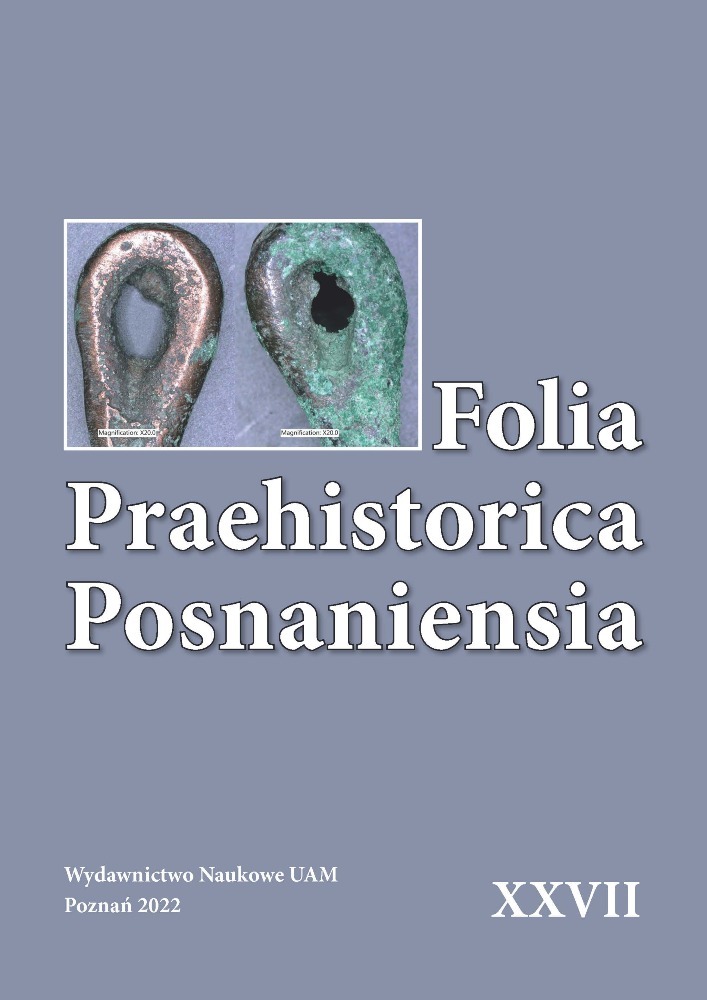Abstract
Sources of knowledge of treatment practices in the La Tène period in Central Europe are limited. Archaeologists very often classify findings on the basis of their personal opinions which are not substantiated by evidence. The theories that have been proposed so far are not widely accepted by the academics. Artefacts that are expected to be used for diagnostics and treatment are not usually chosen to deduce the form and processes of therapeutic practice in the La Tène period. The main issue of the topic is the possibility to distinguish between tools for therapeutic procedures and artefacts created for other purposes. However, there is also the question of whether it is possible to distinguish between tools originating from Central Europe and tools originating in the Roman or Greek environment, artefacts which originated in the studied period from medieval or modern objects, and the real artefacts, for which there are no suitable analogies, from counterfeits created in the 18th‒19th centuries. For this purpose, specific debatable sets of artefacts are used. The goal of the research is to clarify the real purpose of the examined artefacts, for which it was previously proposed that they were used for therapy or diagnostics in the La Tène period. The results of the review and analysis of the artefacts have their explanatory ability about the state of practice in the studied geographical area.
References
Ascher, R. (1961). Experimental Archeology. American Anthropologist, 63, 793-816. https://doi.org/10.1525/aa.1961.63.4.02a00070 DOI: https://doi.org/10.1525/aa.1961.63.4.02a00070
Bliquez, L. (2014) (ed.). The tools of Asclepius: surgical instruments in Greek and Roman times. Leiden-Boston: Brill. https://doi.org/10.1163/9789004283596 DOI: https://doi.org/10.1163/9789004283596
Bostock, J., Riley, H. T. (1855). Pliny the elder. The natural history. Vol. 2. London: H. G. Bohn. Dungworth, D. (1997). Iron Age and Roman copper alloys from northern Britain. Internet Archaeology, 2. DOI: https://doi.org/10.11141/ia.2.2 DOI: https://doi.org/10.11141/ia.2.2
Figueiredo, E., Silva, R. J., Araújo, M. F., Fernandes, F. M. B. (2013). Multifocus optical microscopy applied to the study of archaeological metals. Microscopy and Microanalysis, 19(5), 1248-1254. https://doi.org/10.1017/S1431927613001608 DOI: https://doi.org/10.1017/S1431927613001608
Gibbins, D. (1997). More underwater finds of Roman medical equipment. Antiquity, 71(272), 457-459. Gostenčnik, K. (2002). Medizinische Instrumente vom Magdalensberg in Kärntner. Antichità altoadriatiche, 51, 161-177. https://doi.org/10.1017/S0003598X00085094 DOI: https://doi.org/10.1017/S0003598X00085094
Gostenčnik, K. (2004). Die medizinische Versorgung in der Stadt auf dem Magdalensberg. In G. Piccottini (ed.), Die Ausgrabungen auf dem Magdalensberg: 1986 bis 1990. Verlag des Geschichtsvereines für Kärnten (p. 357-442). Klagenfurt: Verlag des Landesmuseums für Kärnten.
Gostenčnik, K. (2013). Medizinische Instrumente aus Lauriacum in den Sammlungen der Oberösterreichischen Landesmuseen. Römisches Österreich, 36, 95-107.
Grasselt, T. (1994). Die Siedlungsfunde der vorrömischen Eisenzeit von der Widderstatt bei Jüchsen in Südthüringen. Weimarer Monographien zur Ur- und Frühgeschichte Bd. Vol. 31. Stuttgart: K. Theiss.
Guillaumet, J. P. (2016). Le soin aux chevaux à l'époque celtique: trousses de vétérinaires et attestation du fer à cheval. Pallas. Revue d'études antiques, 101, 53-63. https://doi.org/10.4000/pallas.3809 DOI: https://doi.org/10.4000/pallas.3809
Härtl, P. (2005). Die besondere Bedeutung und Behandlung des menschlichen Kopfes innerhalb der Latènekultur Mittel- und Westeuropas. Bonn: Habelt.
Hubinger, V. (1988). Etnos a etnikum. Český lid, 75, 43-50.
Jackson, R. (1995). The composition of Roman medical instrumentaria as an indicator of medical practice: a provisional assessment. Ancient Medicine in Its Socio-Cultural Context, 1, 189-207. https://doi.org/10.1163/9789004418370_017 DOI: https://doi.org/10.1163/9789004418370_017
Jacobi, G. (1974). Werkzeug und Gerät aus dem Oppidum von Manching. Die Ausgrabungen in Manching. Vol. 5. Wiesbaden: W. Krämer.
Jakielski, K. E., Notis, M. R. (2000). The metallurgy of Roman medical instruments. Materials characterization, 45(4-5), 379-389. https://doi.org/10.1016/S1044-5803(00)00078-4 DOI: https://doi.org/10.1016/S1044-5803(00)00078-4
Kábrt, J., Kábrt, J. jr. (2004). Lexicon medicum. Praha: Galén.
Kern, A. (1996). Spatlatènezeitliche Funde vom Oberleiserberg, MG Ernstbrunn, N O. In E. Jerem et al. (eds.), Die Kelten in den Alpen und an der Donau, Akten des Internationalen Symposions St. Pölten 1992 (p. 385-393). Budapest - Wien: E. Jerem.
Künzl, E. (1987). Archäologische Dokumente zur Medizin der Kelten. In Archéologie et médecine (p. 271-274). Juan les Pins: APDCA.
Künzl, E. (1995). Medizin der Kelten. Ein archäologischer Forschungsbericht. In R. Bedon, P. M. Martin (eds.), Mélanges Raymond Chevalier. Vol. 2: Histoire & Archéologie. Vol. 2: Caesarodunum. Vol. 24 (p. 221-240). Tours.
Ménager, M., Tísoc, E. R. M., Cavallini, C., Conejo, P. S., Barboza, N., Salgado, S. (2021). Combining analytical chemistry and traceology: An innovative approach applied to Mesoamerican mirrors found at the Sojo site (Costa Rica). Journal of Archaeological Science, 125, 105302. https://doi.org/10.1016/j.jas.2020.105302 DOI: https://doi.org/10.1016/j.jas.2020.105302
Milne, J. S. (1907). Surgical instruments in Greek and Roman times. Oxford: Clarendon Press.
Parzinger, H., Nekvasil, J., Barth, F. E. (1995). Die Býčí skála-Höhle: ein hallstattzeitlicher Höhlenopferplatz in Mähren. Mainz am Rhein: P. von Zabern.
Píč, J. L. (1903). Starožitnosti země České II. 2. Hradiště u Stradonic jako historické Marobudum. Praha: J. L. Píč.
Pieta, K. (2008). Keltské osídlenie Slovenska. Mladšia doba laténska. Nitra: Archeologicky ustaw SAV. Podborský, V. (1994). Keltský náboženský partikularismus. Náboženství našich prapředků. Brno: Masarykowa universita.
Riha, E. (1986). Römisches Toilettgerät und medizinische Instrumente aus Augst und Kaiseraugst. Augst: Römermuseum August.
Saber, A. (2010). Ancient Egyptian surgical heritage. Journal of Investigative Surgery, 23(6), 327-334. Sáez, C. G., Lerma, I. M. (2015). Traceology on metal. Usewear marks on copperbased tools and weapons. In J. M. Marreiros, J. F. Gibaja Bao, N. F. Bicho (eds.), Usewear and residue analysis in archae- ology (p. 171-188). Edinburgh: Springer, Cham. https://doi.org/10.1007/978-3-319-08257-8_9 DOI: https://doi.org/10.3109/08941939.2010.515289
Sáez, C. G., Moro, P. M. (2020). Traceology on metal. Experiments and interpretation of the archaeological items. Археология Евразийских степей, 3, 172-186.
Sakai, T. (2007). Historical evolution of anatomical terminology from ancient to modern. Anat-Sci-Int, 82, 65-81. https://doi.org/10.1111/j.1447-073X.2007.00180.x DOI: https://doi.org/10.1111/j.1447-073X.2007.00180.x
Teall, E. K. (2014). Medicine and doctoring in ancient mesopotamia. Grand Valley Journal of History, 3(1), 2.
Velázquez Castro, A., Melgar Tisoc, E. R. (2014). Producciones palaciegas tenochcas en objetos de concha y lapidaria. Ancient Mesoamerica, 25(1), 295-308. https://doi.org/10.1017/S0956536114000170 DOI: https://doi.org/10.1017/S0956536114000170
Weller, U., Kaiser, H., Heynowski, R. (2016). Kosmetisches und medizinisches Gerät: erkennen, bestimmen, beschreiben. Deutscher Kunstverlag, Bestimmungsbuch Archäologie. Berlin: Deutscher Kunstverlag.
License
Copyright (c) 2022 Lucie Burešová

This work is licensed under a Creative Commons Attribution 4.0 International License.
